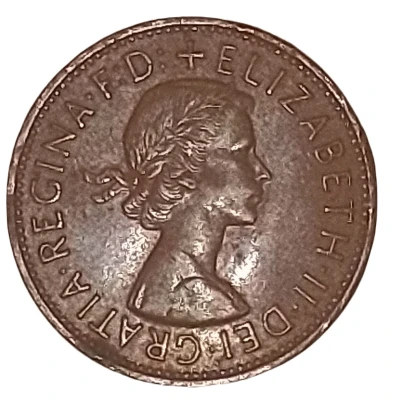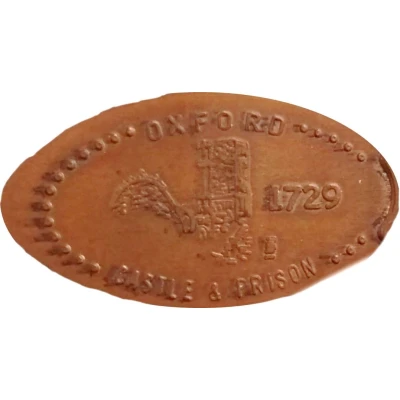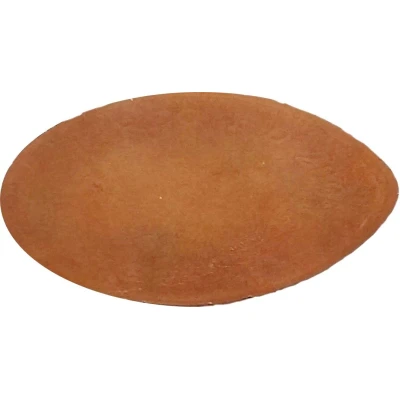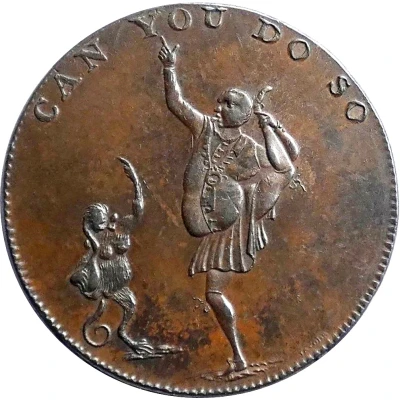
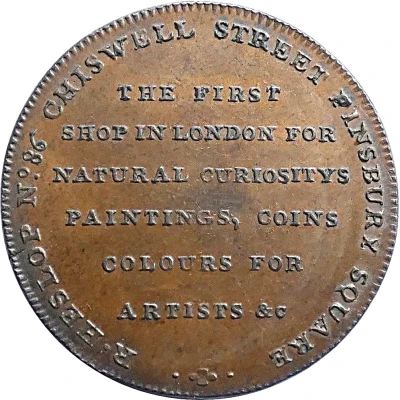

© ZacUK
Token - Heslop's Contortionist ND
1795 year| Copper | 7.66 g | 29.7 mm |
| Location | United Kingdom (United Kingdom, British Overseas Territories and Crown Dependencies) |
|---|---|
| Type | Medals › Advertising medallions |
| Year | 1795 |
| Value | ½ Penny (1⁄480) |
| Currency | Conder tokens (1787-1797) |
| Composition | Copper |
| Weight | 7.66 g |
| Diameter | 29.7 mm |
| Thickness | 1.5 mm |
| Shape | Round |
| Technique | Milled |
| Orientation | Coin alignment ↑↓ |
| Updated | 2024-11-14 |
| Numista | N#152692 |
|---|---|
| Rarity index | 94% |
Reverse
In the centre legend on six lines, and around edge. Border with longer teeth
Script: Latin
Lettering:
R · HESLOP No. 86 CHISWELL STREET FINSBURY SQUARE
THE FIRST SHOP IN LONDON FOR NATURAL CURIOSITYS
PAINTINGS, COINS COLOURS FOR ARTISTS &c
Edge
Plain
Comment
Robert Heslop’s (Middlesex) copper Conder Æ halfpenny token undated (circa 1795).Robert Heslop had a business as a curiosity and coin dealer at 86 Chiswell Street, London. The obverse shows Joseph Clark - who is said to have been the most extraordinary posture master (contortionist) that ever lived. Although rather stout, he appears to have been able to assume the most spectacular positions
There are two errors. The lettering should be CAN YOU DO SO? with question mark, and CURIOSITYS should be CURIOSITIES lettering.
Catalogues: Atkins p.96, 235a; D&H Middlesex 336a or 336b
Designer's name (see below) looks like T . col . f . [T col fecit = T col made me]
-----
This privately issued halfpenny advertises the Finsbury Square shop of London dealer Robert Heslop. During the 1790's and early 1800's Heslop traded in an eclectic range of natural history and ethnographic curios – many no doubt acquired directly from sailors and others who had visited New Holland and the South Seas – as well as paintings, artist supplies and coins. The image on the reverse is after an engraving by Marcellus Laroon of the famous contortionist Joseph Clark (died before 1697). The engraving titled 'Clark the English Posture Master', was published in 'The Cryes of the City of London Drawne after the Life' (1688).
An interesting example of late eighteenth-century British privately issued coinage. Such tokens are known as Conder tokens, after the numismatist James Conder who produced the first catalogue devoted to them in 1798.
Conder, p. 89, 161: Dalton & Hamer, The provincial token-coinage of the 18th century, Middlesex 336b: Pye, The virtuoso's companion, p. 30: Atkins, Tradesmen's tokens of the eighteenth century, p. 96, 235b.

